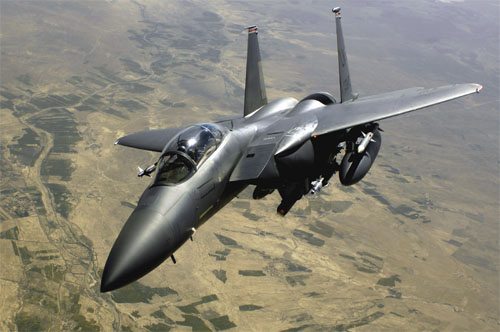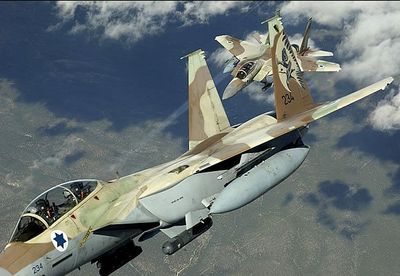The first flight of FC-1/JF-17 Thunder took place in August 2003. Five prototypes are ready by now which are undergoing testing. Pakistan will receive 10 of JF-17 Thunder aircrafts after June, 2006 for training purpose. The serial production will start in January, 2007 in Chengdu Aircraft Company.
Type
FC-1 / JF-17 Thunder is a single seat, single engine, All-whether, day-night Air Superiority fighter with limited ground attack capabilities.
Program
The “Saber-II” program started in 1990 with US assistance. The Northrop Grumman and CAC worked until 1992, the US cancelled this project. However, China managed to continue the project. This project was renamed as FC-1 (Fighter China-1) and it was then supported by the Russian Mikoyan OKB. In 1995, China invited Pakistan to join the project so that Pakistan could fill its fighter gap. Pakistan invested 75 million USD (half of the total development cost) and accelerated the project. The entire design of the aircraft was changed. The aircraft was supposed to be received in 2000-2001 but due to the Indian plan of purchasing Su-30 fighters, Pakistan asked China to make this aircraft BVR capable. China had been running its BVR missile project to replace its R-73. This missile, the SD-10, is believed to be carried by the FC-1. The SD-10 medium-range missile is under testing stage and will be ready by 2005.
The first flight of FC-1 / JF-17 took place in August 2003. Five prototypes are ready by now which are undergoing testing. Pakistan will receive 10 of these aircrafts after June, 2006 for training purpose. The serial production will start in January, 2007 in Chengdu Aircraft Company.
[table id=2 /]
Source: AFM
Design Features
The JF-17 Thunder possesses a third generation airframe. Mid-mounted wings and position of intakes are pretty similar to F/A-18 and helps in reducing signature. Wings are situated quite after the canopy which gives the JF-17 higher instantaneous turn rate and climb rate. Although, its overall maneuverability is 70% that of the F-16 Falcon but its high climb rate makes the aircraft able to challenge early fourth generation fighters. {mosimage}The enlarged bubble canopy will give the pilot better features, including the rare view. The horizontal stabilizers and elevators on the sides of fuselage will give the wings of the aircraft a better angle of attack. Although the airframe does not use composites; the fuselage is composed of aluminium alloys. After having lack of composites, the JF-17 Thunder still gives a thrust to weight ratio of 0.95, payload of 3800 kg and a maximum speed of Mach 1.6. The unstable design increases the performance of the aircraft in CIC/Dogfight as well as in Supersonic intercepting.
Avionics
The Chinese FC-1 will use Israeli Elta-2032 Radar since the JL-7 radar is under development stage. Another radar project running is China is the JL-10 and these two radars will be installed in Fc-1 and J-10 respectively. The JF-17 will use Italian FIAR Grifo S-7 Pulse Doppler Radar. Initially, PAF negotiated for French radar (RC-400) and BVR missiles but France was trying to make Pakistan its customer for the Mirage 2000-5 aircraft and refused to sell radars and missiles. This led PAF to go for its last option i.e. Grifo S-7. This radar was purchased under transfer of technology agreement.
The Grifo radars are also installed in F-7P, F-7PGs and Mirage III/Vs of PAF. The Grifo M radar, installed in the Mirage III, have proved to be pretty capable, giving the aircraft limited BVR capability. Therefore, it will be easier for the PAF to continue with the Grifo series. The Grifo S-7 will have look-down/shoot-down capability and will be a better platform for the PAF in BVR role. It is rumored that this radar lacks multi-targets tracking capability; however, the manufacturers are still quiet about the technical details of the radar until it enters production. FLIR pod is also absent in the avionic suite.
Other avionic systems include a smart Head-Up-Display (HUD), GPS/IPS and two smart Multi-Functional colored Displays. It will also have UOMZ SH-3UMI helmet-mounted sight (the same used in the Russian MiG-29) and dual digital FBW. The avionic systems also include IRSTS, CLDP and Helmet Mounted Display which will help the carry all-weather operations.
Power Plant
The JF-17 will be powered by one Klimov RD-93 turbofan, (an upgraded version of RD-33) which generates more thrust and being more fuel efficient then its previous version. The engine gives 11,000 pounds (49.4 kN) dry and 18,300 pounds (81.4 kN) of thrust with afterburning. The engine will be built in China under license.
Armament/Weapons
The JF-17 Thunder has 7 store stations and a payload of 3,800 kg. PL-8, PL-9C and AIM-9P are the short range missiles this aircraft will be armed with. The SD-10/PL-12 will be the BVR weapon of the JF-17 Thunder. The missile is based on Russian R-77 BVR missile and has a maximum range of more then 70 km.
For strike purpose, JF-17 will be able to carry Chinese LGB, Cluster Bombs, anti-runway bombs etc. The naval version of this JF-17 will be armed with AM-39 Exocet missiles for anti-ship missions. The future versions will also be having inflight refueling probe and deck arrester hook installed which will increase the striking range beyond 3000 km.
Self-Defense
For self-defense, this aircraft is armed with GSh-23 mm canon (anti-tank) which has a fire rate of 840 rounds /minute. The Electronic Counter Measures systems also include sensors like RWR and MAWS.
Latest Updates
According to well placed sources, the JF-17 prototype 04 has passed the first phase of testing. The testing of prototype 05 will start next year to examin avionics systems and weapons. It was said that the ferry range of this aircraft is close to 3,500 km and an operational radius of more then 1300 km.
May 12th, 2006 – During the test flights of FC-1 / JF-17 Thunder Prototype 04 on April 28th, 2006 and inaugural flight on May 9th witnessed by Pakistan Air Force airchief the changes made to the aircraft are clearly visible in pictures here. The fourth prototype (04) has been redesigned with F-35 JSF style Divertless Supersonic Intakes (DSI) being the most notable feature; according to Lockheed Martin, DSI is more stealthy than other conventional air intakes as well as DSI also diverts turbulent boundary-layer airflow away from the engine inlet
Some of the changes that were observed in JF-17 protoype 04:
- Redesigned air intakes (DSI)
- Larger wing leading-edge root extensions
- Taller less swept Fin
- Longer Ventral strakes at both sides of the AFT fuselage
- Improved Weapon and Electronics systems
These changes were made due to problems that were faced during test flights of first three prototypes.
The production is set to start in 2006in China. Pakistan has placed initial order of 16 aircraft assembly of which will be shared between China’s Chengdu Aircraft and Pakistan’s Pakistan Aeronatical Complex (PAC) for Pakistan Air Force. Pakistan plans to buy 150 aircraft, of which 134 will be locally assembled by PAC.
[table id=1 /]
[ppgallery id=”1″]
Copyright: Defencetalk.com









